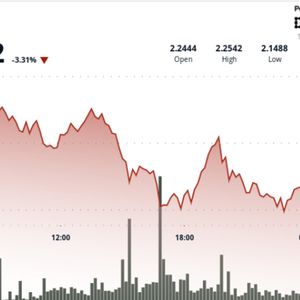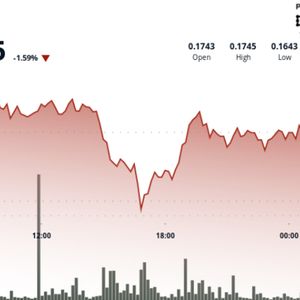China Tariffs: Potential Relief on Semiconductor Imports Sparks Hope for Global Economic Outlook, Crypto Market Watches Closely
7 min read
Hey there, crypto enthusiasts and market watchers! While our primary focus is the exciting world of digital assets, it’s crucial to remember that the crypto market doesn’t exist in a vacuum. It’s deeply intertwined with the broader global economic outlook , geopolitical shifts, and technological advancements. That’s why a recent development regarding US China trade relations has caught our eye, and it’s worth exploring how it might ripple through the global economy and potentially touch the crypto space. The big news making rounds is that China is reportedly considering a significant move: waiving a hefty 125% tariff on certain imports from the United States. This comes amidst subtle conciliatory gestures from the US side, with President Donald Trump having previously hinted at a willingness to potentially lower tariffs on Chinese goods. According to Reuters, citing reports from China’s local news outlet Caijing, Beijing is looking at incorporating eight specific items tied to semiconductors into a list of tariff exemptions. It’s important to note that memory chips are excluded from this particular consideration, but the focus on semiconductors is highly significant. Understanding the Context: The US China Trade War and China Tariffs To fully grasp the potential implications of this move, let’s quickly rewind and understand the backdrop. The past few years have seen escalating trade tensions between the two largest economies in the world, the United States and China. This period, often dubbed the ‘US China trade war,’ involved both countries imposing significant tariffs on a wide range of each other’s goods. The goal from the US perspective was often cited as addressing trade imbalances, protecting intellectual property, and encouraging manufacturing at home. China’s tariffs were largely seen as retaliatory measures. These China tariffs , like the 125% rate mentioned, weren’t just numbers on a page; they had real-world consequences. They increased the cost of imported goods, impacting businesses and consumers alike. For sectors heavily reliant on international trade and components, such as technology, the tariffs created significant disruptions to supply chains and increased operational costs. The semiconductor industry, being highly globalized and critical for virtually all modern technology, was inevitably caught in the crossfire. Why Are Semiconductor Tariffs Particularly Important? The fact that China is specifically targeting semiconductor tariffs for potential exemption is telling. Semiconductors, or microchips, are the foundational technology of the 21st century. They are the ‘brains’ in everything from smartphones and computers to cars, industrial machinery, and advanced data centers. Here’s why they are so critical: Essential for Technology: Without semiconductors, modern computing, communication, and data processing are impossible. Global Supply Chains: The design, manufacturing, and assembly of semiconductors involve a complex, interconnected global network. Tariffs disrupt this flow. Economic Competitiveness: A nation’s access to and ability to produce advanced semiconductors is increasingly seen as a key factor in its economic and technological competitiveness. Strategic Importance: Semiconductors are vital for defense, AI, and other strategic technologies, making them a point of geopolitical focus. A 125% tariff is an extremely high barrier, effectively making these US-origin semiconductor-tied items prohibitively expensive for Chinese buyers. Removing or waiving such a tariff, even on a limited list of items, signals a potential shift in strategy and could have tangible effects on the relevant industries. What Does This Potential Tariff Waiver Entail? Based on the reports, China is considering adding eight specific items related to semiconductors (excluding memory chips) to an exemption list. While the exact items aren’t detailed in the initial reports, the focus is clearly on components or related goods within the semiconductor ecosystem. Waiving the 125% tariff on these items would mean: Lower import costs for Chinese companies needing these specific US products. Potentially increased demand for these specific US exports to China. A symbolic gesture indicating a potential willingness to de-escalate trade tensions in specific, strategically important areas. This isn’t a complete reversal of all China tariffs or an end to the trade disagreements, but it represents a targeted easing, focusing on a sector that is vital for China’s own technological ambitions and global supply chain integration. Analyzing the Potential Impact on the Global Economic Outlook Any positive movement in US China trade relations is generally viewed favorably by global markets. The trade war created significant uncertainty, depressed business investment, and slowed global economic growth. Even a partial step towards easing tensions, like waiving specific semiconductor tariffs , can contribute to a more positive global economic outlook by: Reducing Supply Chain Costs: For companies globally that rely on components flowing between the US and China, reduced tariffs can lower costs and improve efficiency. Boosting Business Confidence: Predictable trade environments encourage businesses to invest and expand. Easing tensions reduces risk. Stimulating Trade: Lower tariffs can lead to increased trade volumes in the affected sectors. Setting a Precedent: This move could potentially open the door for further tariff reductions or more constructive trade dialogues in the future. While the direct economic impact of waiving tariffs on just eight items might seem small in the grand scheme of US-China trade, its significance lies in the signal it sends about the willingness of both sides to find areas of cooperation, particularly in a sector as critical as semiconductors. Connecting the Dots: Potential Crypto Market Impact Now, let’s bring it back to the crypto world. How could a change in semiconductor tariffs or the broader global economic outlook influenced by US China trade relations affect the crypto market impact ? The connection is multifaceted: Semiconductor Supply Chains and Hardware: Crypto mining, especially for Proof-of-Work cryptocurrencies like Bitcoin, relies heavily on specialized hardware (ASICs) which are packed with semiconductors. While the exemption might not directly cover the specific chips used in ASICs or GPUs for mining (especially if memory chips are excluded), broader tariff reductions in the semiconductor space can potentially ease supply chain pressures and lower costs for manufacturers of tech hardware globally. This could, in the long run, influence the availability and cost of mining equipment, although this is an indirect and potentially minor effect from this specific exemption. Investor Sentiment and Risk Appetite: This is perhaps the most significant link. The crypto market, particularly Bitcoin and other altcoins, is often seen as a risk asset. When the global economic outlook is uncertain or negative (as during peak trade war tensions), investors tend to move towards safer assets. Conversely, signs of economic stability, easing geopolitical tensions, and positive trade developments can boost investor confidence and increase appetite for risk assets, potentially flowing into the crypto market. A de-escalation in US China trade friction is generally positive for global market sentiment. Global Economic Growth: To the extent that easing tariffs contributes to stronger global economic growth, it can create a more favorable environment for technological adoption and investment, including in digital assets and blockchain technology. Technological Innovation: Access to critical semiconductor components at lower costs could potentially accelerate technological development within China and globally, which in turn could indirectly benefit the infrastructure and applications underpinning the crypto and blockchain space. Therefore, while this specific tariff exemption might not cause immediate, dramatic shifts in crypto prices, it’s a data point that contributes to the overall picture of global economic health and international relations – factors that absolutely influence the crypto market impact over time. What Are the Challenges and Limitations? It’s crucial to maintain perspective. This reported move is a potential consideration, not a finalized policy, and it applies only to a limited list of eight items, excluding a major category like memory chips. Several challenges and limitations remain: Partial Measure: This is far from a comprehensive dismantling of all China tariffs or US tariffs. Many other goods remain subject to significant duties. Broader Geopolitical Issues: Trade is just one aspect of the complex relationship between the US and China. Issues like technology competition, intellectual property, and geopolitical influence continue to be sources of tension. Implementation Uncertainty: Details matter. The specific items exempted and the duration of the exemption will determine the actual impact. Potential for Re-escalation: Trade relations can be volatile. A positive step today doesn’t guarantee future stability. So, while this is a potentially positive signal for the global economic outlook and US China trade relations in a specific sector, it doesn’t mean the ‘trade war’ is over. It’s a nuanced development in an ongoing complex relationship. Actionable Insights for Crypto Investors Given this development, what should crypto investors take away? Firstly, continue to monitor global economic news, not just crypto-specific headlines. Developments in major economies and international trade relations are key indicators of overall market sentiment and liquidity, which can influence the crypto market impact . Secondly, understand that the crypto market is influenced by macro factors. While specific news like this tariff consideration might not directly correlate with immediate price movements, the cumulative effect of positive or negative global economic signals contributes to the broader market environment for digital assets. Thirdly, recognize the increasing importance of technology supply chains, including semiconductors, for the underlying infrastructure that supports the crypto ecosystem (mining, data centers, exchanges). While this specific exemption might have minimal direct impact, paying attention to the health and stability of the global tech supply chain is relevant. Conclusion: A Glimmer of Hope in US China Trade? China’s reported consideration of waiving the 125% tariff on a partial list of US semiconductor-tied imports is a notable development in the ongoing US China trade dynamic. It signals a potential willingness to ease tensions in a strategically important sector, contributing positively, albeit cautiously, to the global economic outlook . While this move doesn’t resolve all trade disputes or guarantee smooth sailing ahead, it represents a potential step towards de-escalation. For the crypto market, the primary significance lies in how such developments influence overall investor sentiment and the broader economic environment. A more stable and cooperative global economy generally provides a more favorable backdrop for risk assets like cryptocurrencies. We’ll be watching closely to see if this consideration translates into concrete policy and whether it paves the way for further positive steps in international trade relations, ultimately shaping the crypto market impact in subtle but meaningful ways. To learn more about the latest global economic outlook trends and their potential influence on digital assets, explore our articles on key developments shaping the crypto market impact and investment strategies.

Source: Bitcoin World



